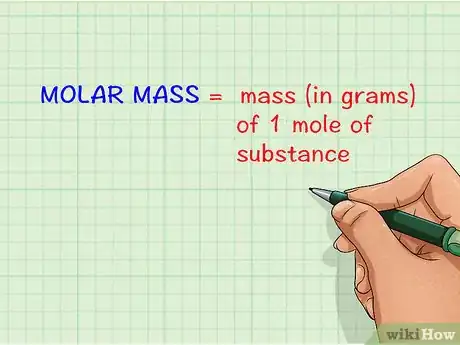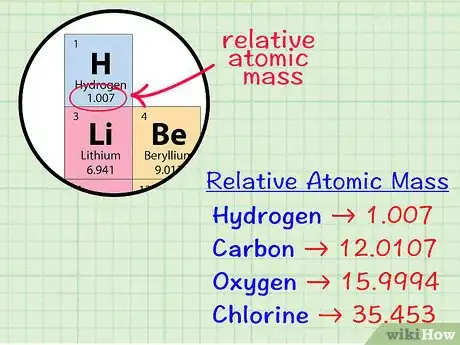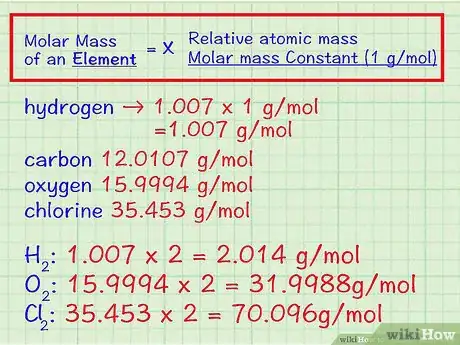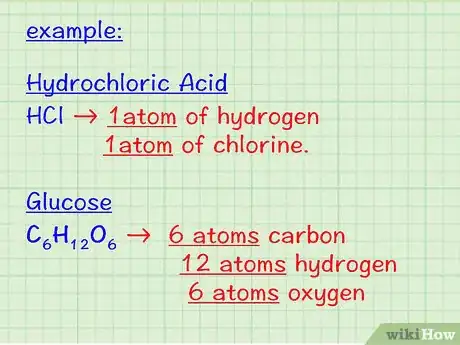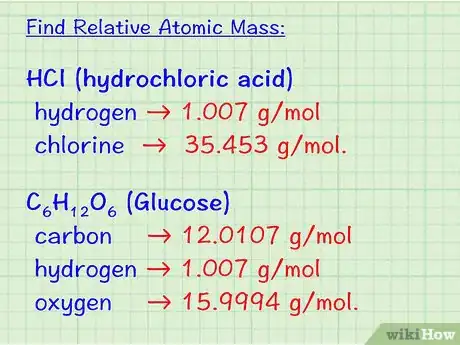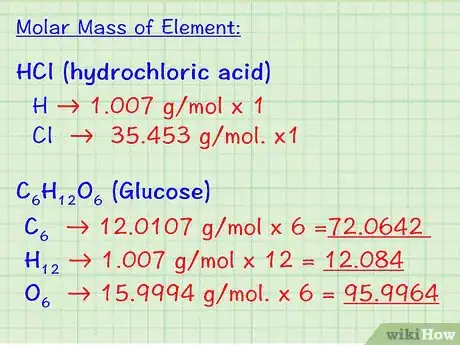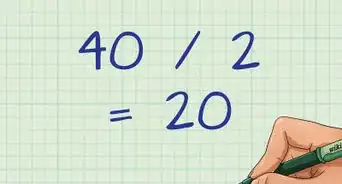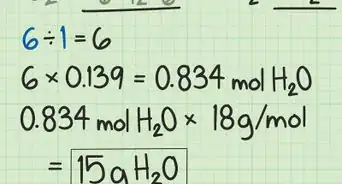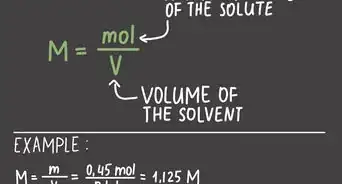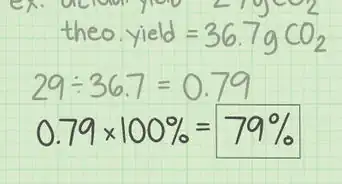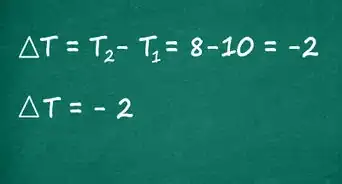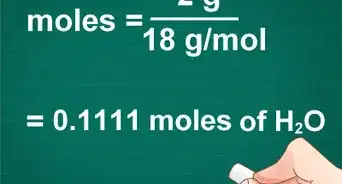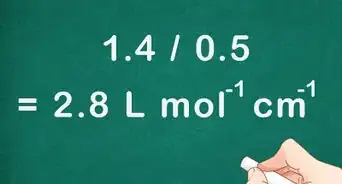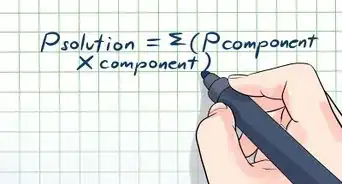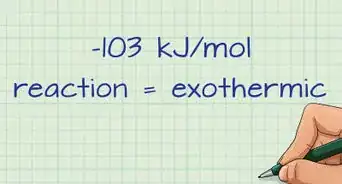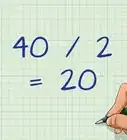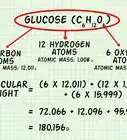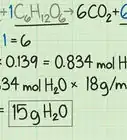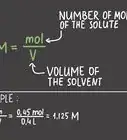This article was co-authored by Bess Ruff, MA. Bess Ruff is a Geography PhD student at Florida State University. She received her MA in Environmental Science and Management from the University of California, Santa Barbara in 2016. She has conducted survey work for marine spatial planning projects in the Caribbean and provided research support as a graduate fellow for the Sustainable Fisheries Group.
There are 9 references cited in this article, which can be found at the bottom of the page.
wikiHow marks an article as reader-approved once it receives enough positive feedback. This article has 13 testimonials from our readers, earning it our reader-approved status.
This article has been viewed 1,249,584 times.
Atoms are too small to allow meaningful measurement of chemical substances. To work with meaningful amounts of substances, scientists group them into units called moles. A mole is defined as the number of carbon atoms in 12 grams of the isotope carbon-12,[1] which is roughly 6.022 x 1023 atoms. This number is called Avogadro's number or Avogadro's constant.[2] This constant is used as the number of atoms given by one mole for any substance, and the mass of 1 mole of a substance is its molar mass.
Steps
Calculating the Molar Mass of an Element
-
1Understand molar mass. Molar mass is the mass (in grams) of one mole of a substance.[3] Using the atomic mass of an element and multiplying it by the conversion factor grams per mole (g/mol), you can calculate the molar mass of that element.
-
2Find the relative atomic mass of the element. An element's relative atomic mass is the average mass, in atomic units, of a sample of all its isotopes.[4] This information can be found on the periodic table of elements. Locate the element and find the number underneath the symbol for the element. It will not be a whole number, but will have decimals.
- For example, for hydrogen, the relative atomic mass is 1.007; for carbon, it is 12.0107; for oxygen, it is 15.9994; and for chlorine, it is 35.453.
Advertisement -
3Multiply the relative atomic mass by the molar mass constant. This is defined as 0.001 kilogram per mole, or 1 gram per mole. This converts atomic units to grams per mole, making the molar mass of hydrogen 1.007 grams per mole, of carbon 12.0107 grams per mole, of oxygen 15.9994 grams per mole, and of chlorine 35.453 grams per mole.[5]
- Some elements are only found in molecules of 2 atoms or more. This means that if you want to find the molar mass of elements that are composed of 2 atoms, such as hydrogen, oxygen, and chlorine, then you'll have to find their relative atomic masses. Multiply them by the molar mass constant, and then multiply the result by 2.
- For H2: 1.007 x 2 = 2.014 grams per mole; for O2: 15.9994 x 2 = 31.9988 grams per mole; and for Cl2: 35.453 x 2 = 70.096 grams per mole.
- One mnemonic device for remembering diatomic elements (molecules of 2 atoms) is: Have No Fear Of Ice Cold Beverages (Hydrogen, Nitrogen, Fluorine, Oxygen, Iodine, Chlorine, Bromine).[6]
Calculating the Molar Mass of a Compound
-
1Find the chemical formula for the compound. This is the number of atoms in each element that makes up the compound. (This information is given in any chemistry reference book.) For example, the formula for hydrogen chloride (hydrochloric acid) is HCl; for glucose, it is C6H12O6. Using this formula, you can identify the number of atoms of each element that makes up the compound.[7]
- For HCl, there is one atom of hydrogen and one atom of chlorine.
- For C6H12O6, there are 6 carbon atoms, 12 hydrogen atoms, and 6 oxygen atoms.
-
2Find the relative atomic mass of each element in the compound. Using the periodic table, locate the relative atomic mass for each element. It is the number located beneath the symbol for the element.[8] As we did in the first method of calculating the molar mass of an element, we will also multiply these masses by 1 gram/mole.
- The relative atomic masses of the elements in hydrochloric acid are: hydrogen, 1.007 g/mol and chlorine, 35.453 g/mol.
- The relative atomic masses of the elements in glucose are: carbon, 12.0107 g/mol; hydrogen, 1.007 g/mol; and oxygen, 15.9994 g/mol.
-
3Calculate the molar mass of each element in the compound. Multiply the element's atomic mass by the number of atoms of that element in the compound. This will give you the relative amount that each element contributes to the compound.[9]
- For hydrogen chloride, HCl, the molar mass of each element is 1.007 grams per mole for hydrogen and 35.453 grams per mole for chlorine.
- For glucose, C6H12O6, the molar mass of each element is: carbon, 12.0107 x 6 = 72.0642 g/mol; hydrogen, 1.007 x 12 = 12.084 g/mol; and oxygen, 15.9994 x 6 = 95.9964 g/mol.
-
4Add the molar masses of each element in the compound. This determines the molar mass for the entire compound. Take the products you obtained in the previous step and add them all together to calculate the molar mass of the compound.[10]
- For hydrogen chloride, the molar mass is 1.007 + 35.453 = 36.460 g/mol. 36.46 grams is the mass of one mole of hydrogen chloride.
- For glucose, the molar mass is 72.0642 + 12.084 + 95.9964 = 180.1446 g/mol. 180.14 grams is the mass of one mole of glucose.
Expert Q&A
Did you know you can get expert answers for this article?
Unlock expert answers by supporting wikiHow
-
QuestionWhat is the molar mass of Helium?
 Bess Ruff, MABess Ruff is a Geography PhD student at Florida State University. She received her MA in Environmental Science and Management from the University of California, Santa Barbara in 2016. She has conducted survey work for marine spatial planning projects in the Caribbean and provided research support as a graduate fellow for the Sustainable Fisheries Group.
Bess Ruff, MABess Ruff is a Geography PhD student at Florida State University. She received her MA in Environmental Science and Management from the University of California, Santa Barbara in 2016. She has conducted survey work for marine spatial planning projects in the Caribbean and provided research support as a graduate fellow for the Sustainable Fisheries Group.
Environmental Scientist
-
QuestionWhat is the molecular mass of oxygen and hydrogen as a mixture?
 Community AnswerOxygen with Hydrogen gives you WATER (H2O). The relative atomic mass for Oxygen is 16, while Hydrogen is 1 since Hydrogen (H2) have two molecules you multiply by 2 1*2=2. Oxygen (O) being 16*1=16. Add up your answers to get 18, and the molecular mass of Oxygen and Hydrogen which is water gives you 18.
Community AnswerOxygen with Hydrogen gives you WATER (H2O). The relative atomic mass for Oxygen is 16, while Hydrogen is 1 since Hydrogen (H2) have two molecules you multiply by 2 1*2=2. Oxygen (O) being 16*1=16. Add up your answers to get 18, and the molecular mass of Oxygen and Hydrogen which is water gives you 18. -
QuestionHow do you calculate the molar mass of water?
 Community AnswerWater's chemical formula is H2O, this means it is composed of 2 Hydrogen atoms and 1 Oxygen atom. To find the molar mass, find the atomic mass of all the components of a chemical. You can either memorize it, or find all of the atomic masses located on the periodic table of elements. In this case, hydrogen has an atomic mass of 1, and oxygen has an atomic mass of 16. The equation is therefore: 1(2) + 16(1) = 18. Therefore, the molar mass of water, is 18.
Community AnswerWater's chemical formula is H2O, this means it is composed of 2 Hydrogen atoms and 1 Oxygen atom. To find the molar mass, find the atomic mass of all the components of a chemical. You can either memorize it, or find all of the atomic masses located on the periodic table of elements. In this case, hydrogen has an atomic mass of 1, and oxygen has an atomic mass of 16. The equation is therefore: 1(2) + 16(1) = 18. Therefore, the molar mass of water, is 18.
Things You'll Need
- Chemistry reference book or periodic table of the elements
- Calculator
References
- ↑ https://www.khanacademy.org/science/chemistry/atomic-structure-and-properties/introduction-to-the-atom/v/the-mole-and-avogadro-s-number
- ↑ http://www.chemteam.info/Mole/MolarMass.html
- ↑ http://preparatorychemistry.com/Bishop_molar_mass_conversion_factors_help.htm
- ↑ http://www.chemteam.info/Mole/AverageAtomicWeight.html
- ↑ https://chem.libretexts.org/Bookshelves/Physical_and_Theoretical_Chemistry_Textbook_Maps/Supplemental_Modules_(Physical_and_Theoretical_Chemistry)/Atomic_Theory/The_Mole_and_Avogadro's_Constant
- ↑ http://www.tutapoint.com/knowledge-center/view/remembering-the-diatomic-elements/
- ↑ https://chem.libretexts.org/Courses/University_of_British_Columbia/CHEM_100%3A_Foundations_of_Chemistry/06%3A_Chemical_Composition/6.9%3A_Calculating_Molecular_Formulas_for_Compounds
- ↑ https://sciencing.com/how-to-find-relative-mass-13710549.html
- ↑ http://www.chemteam.info/Mole/MolarMass.html
About This Article
When you’re measuring extremely tiny amounts of a substance, it can be helpful to use molar mass. According to the International System of Units, a mole is the amount of any substance that contains the same number of elementary entities—typically atoms or molecules—as there are atoms in 12 grams of the isotope carbon-12. Molar mass is the mass in grams of 1 mole of any given substance. To find an element’s molar mass, start by checking the periodic table for the relative atomic mass of the element. This is usually located under the symbol and name of the element. For instance, the relative atomic mass of zirconium (Zr) is 91.22. Next, multiply the atomic mass by the molar mass constant, which is equal to 1 gram per mole. For most elements, this means that the relative atomic mass is equal to the molar mass. For instance, zirconium has a molar mass of 91.22 x 1 g/mol, or 91.22 g/mol. However, some elements, such as hydrogen, nitrogen, and oxygen, only occur naturally in molecules of 2 or more atoms. In these cases, you’ll need to multiply the relative atomic mass of the element by the number of atoms in the molecule, then multiply the result by the molar mass constant. For example, the molar mass of H2 is 1.007 x 2 x 1 g/mol, or 2.014 g/mol. Finding the molar mass of a compound is a little more complicated. First, you’ll need to find the chemical formula for the compound. For example, if you’re calculating the molar mass of water, you’d start with the formula H2O. Then, calculate the molar mass of each element in the compound. Don’t forget to take into account the number of atoms of each element when you make your calculation. In this case, the molar mass of the two hydrogen atoms is 2.014 g/mol, while the single oxygen atom is 15.999 g/mol. Add them together to get the total molar mass of 18.013 g/mol. To see specific examples for how to calculate molar mass, read on!
